独立开发者回顾iOS和Mac游戏发行失败经历
作者:Matej Jan
我再一次登录了IndieCity并希望能够看到游戏销量翻倍的结果。但是事实却并非如此,我所看到的仍是Windows版本的游戏《Monkey Labour》只卖出了7份。
虽然在2个月内只卖出7份游戏是件非常可怕的事,但是我想申明的是本篇文章并不是关于一位幻想破灭的独立开发者的牢骚。这是我在经历了长期的“实验”后所得出的结果,而非抱怨。实际上我也很期待我的下一款游戏的开发,我也仍然坚持于自己所热衷的事业。
当你决定以制作游戏谋生时,你会发现事实总是与你期待的相反。更重要的是,我将阐述的是一个关于游戏发行,市场营销以及销售的故事。我并不是那些只是专注于图像或代码的专业人士,我更喜欢游戏开发过程中的运营部分。所以本篇文章便是关于我所在独立开发游戏中所学到的各种与运营有关的经验教训。
在开始前我们需要注意的一点是:《Monkey Labour》是由一家小型工作室Dawn of Play(由大型研究兼开发公司Razum所创建)所开发的游戏。尽管我是这个开发团队中的一员,但是从技术上来看我却是一名独立承包人,效力于我的独资公司Retronator。
第一部分:关于iOS的故事
如何创造出一款小型游戏?
我并不想谈太多关于《Monkey Labour》的内容——但是从这款游戏中你便能够想象什么是小而精的游戏。我们的目标是创造出最少的内容,以便我们能够在1至2个月内完成任务。但是仍需要保持较高的游戏质量,这也是我们的准入门槛以及战胜市场上各种游戏的基本要求。
不管是从积极评价来看还是在Metacritic(游戏邦注:专门收集对于电影,电视节目,音乐专辑,游戏的评论的网站)获得75分,我们都足以将《Monkey Labour》称之为一款高质量的小游戏。虽然它并非史上最出色的游戏,但是却因为能够唤起众多玩家怀旧之感而足以称得上是一款优秀的游戏。而从生产角度来看,任何人只要下定决心开始创造自己的第一款商业游戏,便有可能创造出这样的一款游戏。
所以创造并销售一款简单的小游戏需要你投入多少时间?可以确定的是,实际所花费的时间总是比你预想的多出个两三倍。同样这也要取决于不同因素,而最主要的因素则是游戏的大小以及你之前创造游戏的经验。虽然影响因素多种多样,但是我想在此说说我们自己的例子。
我将制作游戏当成是一种兴趣长达15年之久,并且最近我也开始在大学中教授相关学科,可以说我对游戏编程一点都不陌生。同时在接触这个项目之前我也曾花费整个夏天去制作我自己的iOS框架。虽然采用现有的框架效果也是一样的,但是从制作框架过程中我却能够学习到如何去制作一款游戏。但是当Dawn of Play的人员向我呈现了真正的游戏设计后,我才发现这是一种纯粹的执行过程。
换句话说,我拥有一个非常好的基础。但是尽管如此,为了创造出一款带有基本菜单的单屏幕街机游戏,我单单在编程上就花费了109个小时。这是我所接受的长达1个半月的兼职(我会利用每天教书的空档挪出3至4个小时进行这项工作)。而由其他程序员再花2周时间完成Game Center整合(即排行榜和成就)。
可能在今天并不需要花费这么长时间了,但是对于每个不同的项目来说你有可能为了研究一个奇怪的错误而花费长达1周的时间,甚至超越你自己的预算。后来我们又投入了71个小时完成了游戏更新内容。总之,单单代码的工作就需要花费一个全职程序员8周的时间了(假设你每天投入了6个小时的时间进行工作)。
如果你曾经想过每天在放学或工作后躲在卧室里编译代码,你会发现即使你每天投入了2个小时,至少也需要花费6个月的时间才能完成一款简单的街机游戏的所有代码编写以及优化工作(并最终将其推向App Store)。但是这只是关于代码而已啊!完成了这一过程后你的游戏也还未没有任何卖点,你只拥有程序员所创造的图像,但是没有声音,预告片以及相关网页,甚至也只有你的Facebook好友才知道这款游戏的存在——或者是那些仍愿意浏览你的状态更新的人。
当你是以一家公司的身份去做事时,你会发现所有的发展过程将会变得更快,并且它们所耗费的成本也将逐渐增多。你将需要添加内部图像设计师(负责图像与网页设计),总监,管理人,以及外包音效和音乐制作人,并完成iTunes Connect工作等等。并且制作音乐和音效还很烧钱。
当然了,你的游戏也需要一个预告片。这里要涉及到办公室,互联网、会计事务所、消防安全认证等事务,更别说相关法律条款和税务了。而所有的这些任务也需要花费一定的时间,并且你需要重视并落实行动。当我们利用空闲时间幻想着编写下一款《翼飞冲天》时却遗漏了这许多小细节。
我们几乎不可能不延长3倍的计划时间/成本。不论你是与一群好友一起利用空闲时间制作游戏还是在一家游戏公司执行全职工作——花费于游戏制作中的金钱可能会各不相同,但是不管怎样你们所需要投入的工作量却是一样的。而你需要做好举起所有这些任务的准备。
(《Monkey Labour》的团队成员包括:美工,总监,编码员,附加编码员,额外编码员)
也就是这五名人员(再加上两名外包音效和音乐制作人)花费了两个月的时间并投入了5万美元而创造出这款游戏,并将其发布于App Store。
第一款独立游戏能够赚多少?
在过去一年时间里这一问题已经得到了许多人的回答,并且现在我们也了解了关于全职或兼职独立开发者以及业余iOS游戏开发者的一些重要内容:
*他们的大多数游戏(平均25%)能够挣得1000至1万美元的利益。
*而如果你足够幸运,你便属于20%的人群,即能够挣得1万至10万美元的收益。
*但是通常情况下大多数人是属于底层的四分之一人群,也就是只能够挣得100至1000美元。
为什么:平均收益直接取决于你之前发行过的游戏数量。如果这是你的第一款游戏,你的回报便有可能只是500美元。我真心建议你们能够亲自核查这一调查数值,从而帮助你更好地设定自己的期望值而不会与现实偏差甚远。
而思考着你该以何种方式去超越这些数值就像你计划着通过玩彩票而养活自己一样。当然了,中乐透并非完全不可能,但是这种幸运却总是不会发生在自己身上。
为什么不放弃?
一切都是始于游戏最初在App Store中的初始表现,并且那时候也只有你的好友以及一些随机点击游戏的陌生人知道这款游戏的存在。
那时候你会沉浸于第一款游戏通过App Store审核的喜悦,并与同事相约喝酒而猜测游戏在第一天的销量。最终我们在第一天共卖出去52份游戏。并在发行后一周游戏的最终销量停在了260份上。
项目领导尝试着将30封电子邮件发送给各个不同的网站,希望自己的游戏能够出现在这些网站上并吸引用户的注意。我们的确取得了一些蛮好的评价,并且苹果也总是会突出推荐新游戏。这便能够帮助你有效地提升游戏的销量,除了在2011年1月——因为这时候苹果移除一般的游戏链接而只列出2010年最佳游戏。所以虽然我们一直期待着能够得到苹果的推荐,但是却始终难以出现在那一列表上。所以在发行2周内游戏的销量达到了顶峰,也就是270次,并在之后开始减半下滑。
而在发行后的第一个月末我们甚至到达了最悲惨的低潮,即每周平均只售出10份应用。所以我们在第一个月的总销量是790份。而以每款1.99美元的价格计算的话我们共挣得三分之二的收益——你应该能够想象我们此时根本无法兴奋。这是发生在上述所提到的收益调查发行前的事,而我们也是极端艰难地等到了这一结果。
如果是在今天我应该能预料到这种结果,但当时我们甚至未曾感到恐慌。我们认为:“当人们开始注意到游戏后,我们便可以通过发布更新内容而重振旗鼓。”
我在2月份完成了本学期的课程教授,所以我便可以全身心投入到代码编译工作中并完成我在圣诞节前所积攒下的工作。这是一个非常有趣的过程,甚至是在制作病毒传播视频的过程中——如果你能够在Reddit(著名的新闻网站)上发表一篇文章或者在YouTube上上传一个“病毒”视频并想办法获得了5千次点击,这便是一种非常棒的宣传手段。
在我花费了71个小时完成了游戏更新的代码编译后,我又投入了113个多小时去展开游戏的市场营销活动,包括制作一个新的预告片和一个特殊的推销网页以提高我们的Twitter和Facebook页面访问量。同时我还利用剩下的时间于发送数十封请求评论的电子邮件,创造优惠码,并回应各种评论和论坛帖子。而如果你只是想要专注于图像和代码,你就不要想着运行一个独立游戏项目。
推销的总体进展非常顺利,并且我们的社交网站也吸引了超过200人的关注,我们也承诺在更新时将价格调低至0.99美元。游戏再次发行那天我们的livestream更是聚集了许多人共同期待着体验游戏的乐趣!所以我想说的是,如果你不喜欢你现在所做的事,你便会最终选择放弃,特别是在出现了以下数字变动时:
在发行后的第一周我们共卖出了215份游戏,但是接下来一周的销量却只有24份。我不禁认为“我们是否正在回归长尾效应(游戏邦注:即趋于平衡)”。
此时我开始将《Monkey Labour》当成一个失败品了。甚至没有任何媒体愿意为我们的游戏做评论。因为这款游戏只卖出了1000多份,我不仅好奇Dawn of Play是否还会让我接手下一款游戏的制作,甚至是否愿意让我再向相关评论网站发送电子邮件。从下图中你可以看到我在PR上所做的努力:
这比我之前写的第一个版本(重新想象与媒体的交流方式,即通过告知这些媒体你在创造游戏时所经历的个人故事以此感动他们)好多了。但是很显然所有媒体每天会接收到无数与之相类似的电子邮件。结果便是:他们很难会注意到我们的电子邮件并为我们做宣传。
但是却出现了一些让人惊讶的效果。我还记得当我在阅读这篇新闻时甚至兴奋地在大学实验室里跳跃起来:《Monkey Labour》在主流iOS游戏网站TouchArcade中获得了4颗星的评价。因此游戏的销量也开始出现大幅度的窜升:
TouchArcade评论所带来的效果也证明了该网站的名望。它虽然不像苹果那样会推荐一时大热的游戏或者推动游戏呈现在排行榜前列,但确实给予我们这种细分市场的游戏更多的机遇,让我们不再自暴自弃地认为自己的游戏多糟糕。借着这股大势我又写了一封类似的评论请求给其它获得Metacritic认可的媒体,并为游戏争取了11个主要评论。最终游戏获得了75分的高分,从而让我们成为了当时排名最高的一款iOS应用。我的PR经验值得到了显著提高,我也更加信心十足了!我终于知道自己在做些什么了!
一场胜战
其实到了这时候我们便可以就此打住关于《Monkey Labour》的故事阐述了,但是因为这是我们的第一款游戏并且这款游戏也为我们挣得了比其它游戏更多的利益,所以我们认为有必要继续深入探究这款游戏并开始致力于下一款游戏的创造。
但却还不是现在。根据一些数据表示,你的第二款游戏不可能获得双倍的销量。这已经是你所掌握的高潮——不管是指你所获得的玩家还是你所建立的人脉。
我们应该大胆尝试并研究我们所获得的结果。除非你能够亲力亲为并超前继续前进,否则就无法得到真正的答案。这也是我之所以能够完成《Monkey Labour》的原因,而我也开始着手战胜另外一座大山,即可下载的PC领域。
第二部分:台式机并非智能机
证明理念
之前提过我曾经花费了2010年的夏天建造游戏的iOS框架,并在接下来的秋天/冬天教授学生们如何制作iPhone游戏。由于拥有Windows/Xbox的背景,我一直都习惯于使用微软的XNA框架去编写游戏。
这是最整洁的设计目标库之一,非常适合用于教程中。这一框架深受业余和独立开发者的欢迎,甚至是AAA级工作室也会将其当成是快速开发游戏的重要工具。除了只适用于微软平台外,这一框架的确拥有众多优点。所以我便决定向学生们推荐这一框架并将其用于iOS游戏开发的Objective-C语言中。
我以独资经营者的身份注册了Retronator并获得了政府对于自主创业的5000美元补助金。一开始我是计划将这笔资金用于保险经费中,但是后来我还是用其购买了一台iPad并利用剩下的钱赶在夏天重新编写了针对于iOS的XNA框架。我将其命名为XNI,并且这一框架也受到了热烈的欢迎(它并不像Objective-C语言本身)。在2个月的兼职教课期间,我在Dawn of Play的兼职独立游戏开发工作也推动着我更加快速地创造出《Monkey Labour》这款游戏。
在完成了《Monkey Labour》的相关工作后我回到了自己的教授工作中。我撰写了关于XNI的论文,并耐心等待着导师帮我审阅论文草稿。XNI是关于XNA的同类副本,我认为我们必须确保开发者能够轻松地将XNI游戏移植回C#,并基于XNA框架创造出Windows/Xbox/Windows Phone等版本的游戏。
为了将我的代码从Objective-C转变成C#,我决定寻找一些能够用于资源代码转化的工具。当然了我们也不可能手动去重写所有的smalltalk中的括号。在学习了一周有关模糊的功能性程序语言TXL以及写作形式语法和变换规则后,我获得了一个名为Automagical的工作版本内容。通过使用一个按压按钮以及8个多小时的手动调整,我最终完成了面向于Windows的《Monkey Labour》可玩游戏版本。
所以接下来我需要做些什么?我计划将这款游戏发行在一个全新的发行平台上,即IndieCity(类似于Steam或Desura),该平台没有把关人,专注于小型和独立游戏领域。我们最终决定在2011年末发行这款游戏。我真的对这款游戏充满信心,决定在此投入我自己的时间和金钱并在最后与Dawn of Play分算潜在收益。
IndieCity的惨败
这项工作大约花了我一个多月的全职时间(平均每天花费4个小时而总共投入了80个小时),主要包括整合IndieCity成就和排行榜的相关代码,制作该PC版本游戏的网页并确保内容足够有趣,制作一个新的游戏预告片等。我甚至请求一名配音演员在视频末尾通过声音做阐述——而相应的报酬便是30美元,带有我的签名的插图以及《Monkey Labour》的优惠码。所有的工作都需要我亲力亲为,我便不得不为了赶上在IndieCity的发行时间而加快步伐。
我想先说说我喜欢IndieCity的主要原因——我接下来还将阐述它给我们带来如何糟糕的结果。这是一个设计有序的网站。它可以更轻松地进行缩放,并且我们也能在此获得更高的提成(游戏邦注:如果游戏与他们的系统整合在一起便能够获得80%的提成,否则也能够获得75%的提成)。最后且同样重要的是它也支持排行榜和成就,而这两大功能都非常适合我们的《Monkey Labour》。
一开始我认为在IndieCity上发行游戏能够取得巨大的成功,但是结果证明我是错的。并且事态发展也变得更加糟糕了。
首先,我们于12月8日在该网站发行了游戏。一开始我们以为只要万事谨慎就好了,但是一些用户们却将我们的游戏称之为“软发行”,即只是在面向大众前测试系统是否有效。我们将四份游戏卖给了亲朋好友,并认为在游戏“真正发行”(计划在接下来的一周中发行)时会有更多人涌向我们的游戏,并且他们也会忘记我们之前所遇到的各种问题。
我期待一些主流媒体能够对我们的游戏进行报道,并且一些大型的游戏网站也能够针对我们的游戏撰写文章。但是很不幸的是游戏最终都未迎来这种宣传。仅仅在Rock Paper Shotgun上的一篇文章并不足以改变什么。
IndieCity用户的确很喜欢我们的游戏。但是作为一家渴望产生重大影响力的小型初创企业,我们并没有足够的能力能够实现这一目标。不幸的是人们对于IndieCity所获得的任何媒体宣传都不感兴趣,大多数用户都讨厌下载客户端以及DRM。
我想在这篇文章发布后IndieCity的用户基础将获得显著上升,但是我的计划却遭遇了惨败。在2个多月后,游戏的下载量仍然极低:即面向于Windows平台的《Monkey Labour》也仍只卖出7台。
何时放弃
根据经验,我并不打算放弃PC版的《Monkey Labour》。也许在IndieCity上的推销失败了,但是我们仍然拥有一个可靠的产品,并也还未得到许多潜在玩家的关注。这款游戏的iOS版本甚至获得了AppCircus大奖(一个手机应用大赛的奖项)以及Mobile Premier Awards的提名,评委甚至好奇地问我们怎么会只卖出4000份游戏。所以我更加肯定我们拥有一款优秀的游戏,只是在市场营销方面遭遇了失败而已。
为了完成XNI框架,我们最后需要做的便是将游戏从iOS移植到OS X中。因为这两种操作系统都是由Objective-C和相同的基本框架所驱动,所以我便能快速获得一个原生版本并将其运行于我的Mac上。
为了不投入另外一周时间去重新改造成就和排行榜,我们抛弃了在线组件并以一半的价格发行了只带游戏玩法的架构。同时为台式机版本规划联合媒体发行,并且我也可以再次发挥我的PR技能。
当我获得11份Metacritic评价时我便再次燃烧了自信,随之我将类似的电子邮件发送给其它50家媒体以告知我们的游戏将出现在主要的个人电脑平台上。
在完成一整天的电子邮件发送后我便上床睡觉了,并且希望一觉醒来能够看到预想的效果。但是结果却再一次未如我所料。
只有一家媒体报道了这款游戏在Mac上的发行,而Windows版本的发展也仍是老样子——不过有个来自罗马尼亚的网站撰写了一篇正面新闻。但是不管怎么说至少我们在Mac上是头三天(而不是两个月)售出7份游戏。但是在Mac App Store中发行游戏却不等同于在iOS平台上发行游戏,虽然我们未能争取到大量实质性的新闻报道,但是我们仍希望在发行后第一周能够获得超过100的销量。
除此之外我也曾向Steam,Desura以及Big Fish Games发送电子邮件,但是却3次遭到了拒绝。那时我的内心真的非常难过。但是问题并不在于IndieCity,Mac App Store或者媒体,而是因为没人想要看到一款“一岁多”的iPhone游戏出现在PC平台上吧——创新主导着今天的游戏世界。或者我们是时候放弃这一想法了?
我们总是能从艰难困苦中我们获了宝贵的经验,并且我也不认为这是件坏事。我相信只要我们热衷于自己所做的事并从中找到乐趣,那么结果是怎样的其实一点都不重要。当然了,我们有时候会觉得没自信,甚至不止一两次想要停止一切。但是不管怎么说我们都不能用结果去衡量幸福感。
我们总是难以预见任何失败。只有你能够真正去享受过程才是关键。而如果你能在此时坚持下去,你便赢得了胜利。而你在整个过程中便将清楚什么才是真正重要的(这也是我写这篇文章的主要目的)。Windows移植的主要目的是证实XNI理念的合理性。那时候还出现了Automagical——虽然我从未认为人们需要这一产品。而如果我们未向各大技术网站发送电子邮件,更多人将可能发现这一产品并购买它(而不是我们的Windows版《Monkey Labour》)。但是从售价来看我们的游戏只需要1美元而Automagical则要价20美元,想到这一点我们便不禁松了口气。
接受现实结果
我知道我尽力了。尽管最终《Monkey Labour》的销量难以弥补我们的生产成本,但是我仍然敢自信地宣称我们的下一款游戏一定能够做到更好。真心感谢工作室的R&D部门的协助,推动着我们能够再次进行尝试。并且因为对这项工作的热爱与坚持不懈也最终帮助我们完成了游戏。
我的一位大学教授曾经说过,我们总是很难预测任何事物,特别是未来。当我在寻找着一些帮助我们摆脱独立游戏业务的方法时,我也始终观察着大局的发展。我将在此根据自己的经验列出我对于未来的设想:
竞争并获胜。好像所有成功的独立游戏都曾获得IGF的提名。但这是一个“封闭窗口”,并且其中的竞争者也已大量涌现。我们也可以让游戏曝光在像Dream Build Play以及IndieCade等盛事中,但重在参与,让游戏在此现身即可。
向玩家而非游戏开发或社区投入资源。当然了与同事待在一起并讨论游戏开发是件很棒的事,但是你却不能忘记是所面向的是游戏玩家!如果将我花费在TIGSource上的时间挪到Destructoid或Giant Bomb上,我想现在应该有更多人知道我们的游戏吧。征服Reddit你便能够成为赢家。
像重视游戏那样重视市场营销。任何曾经发送过评论请求邮件的人都知道这一点的重要性。如果你不清楚游戏的特别之处,你便等同于在浪费游戏记者的时间,你也会在完成一天的PR工作后感到异常沮丧。你还必须确保你通过电子邮件所传达的内容足够有趣。
试验运营模式。我发现市面上出现了越来越多采用特殊筹资方式的游戏,甚至还有《矮人要塞》这款通过善款而建立起来的免费游戏。我并不打算告诉你IAP将如何改变整款iOS游戏。尽管《蓝精灵村庄》可能无法吸引你想要的硬核用户,但大众融资平台Kickstarters和Humble Bundles的持续发展也告诉了我们玩家愿意为好产品掏腰包。所以现在便是我们打破常规思维的重要时刻!
结论
要点在于:如果你热爱自己现在所做的事,你就需要继续坚持下去——尽管在一开始它未能取得一定成效。从我们这样的故事可以看出,你并不能从“零”开始并幻想着通过一款游戏所赚得的钱去资助下一款游戏(除非你真的足够幸运)。但是如果你热衷于这么做,那便不是什么问题。你将保持日常工作,你也将继续为项目客户制作网页,并且在日常工作结束后开始创造游戏——因为这是你真正想要做的事。
也许从运营上看你的第一款游戏遭遇了失败,但是对于你本身来说这却是一种史诗般的胜利。毕竟,有95%活跃于业余游戏开发论坛的人并没有取得这种成果,但你却做到了这一点。(本文为游戏邦/gamerboom.com编译,拒绝任何不保留版权的转载,如需转载请联系:游戏邦)
Congratulations, Your First Indie Game is a Flop
by Matej Jan
Seven. I log into IndieCity again and check the total sales number to see if, by some miracle, the figure went into double digits. It didn’t. Total units of Monkey Labour for Windows sold: seven. And that’s not thousands.
While selling seven games in two months is horrific in any case, this is not, however, another whiny post from a disillusioned indie game developer. It’s just the result of an experiment at the end of a longer story that needs some explaining. I am not complaining. In fact, I am already happily working on our next game. I still get to work on what I love. In my book that’s all that matters.
What it is, though, is yet another scenario of what can happen when you decide to start making games for a living. More important, it’s a story about game publishing, marketing, and sales. I’m not one of those guys who just want to focus on their art or their code. I love the business side of making games. This article is about what I’ve experienced in a good year of doing so.
One more note before we begin: Monkey Labour was developed by Dawn of Play, a small game studio founded out of a larger research and development company Razum. While I’m part of the team just as much as anyone employed there, I am technically an independent contractor, working under my sole proprietorship Retronator. While I can talk about Monkey Labour’s numbers open handed on most parts, I have exact work figures only for my own contribution to the game.
A peek at my IndieCity dashboard
Part 1: The (iOS) Story
What does it take to make the minimum possible game?
I’m not going to talk much about what Monkey Labour is — in its place you can imagine any small, polished game. The goal is minimal content, so that you can make it in a month or two. It’s very important that it’s nonetheless of good quality, as this is the first barrier of entry, the basic requirement to combat today’s flood of games, if you will.
Suffice it to say that Monkey Labour indeed is such a game, with generally favorable reviews and a score of 75 on Metacritic. It’s not the best thing ever, but still a nice little game that won over the nostalgic hearts of a lot of its players. From a production standpoint, it’s something me or you can realistically create when you decide to make your first commercial game.
So how much time goes into making and selling your simple little game? Two to three times as much as you imagine, that’s for sure. As always, it all depends on a multitude of factors, the major ones being the size of the game and your previous experience with doing exactly the things needed to realize it. This can all vary wildly, but let’s get concrete with our example.
I have been making games as a hobby for over 15 years and recently taught classes about it at university, so I’m no stranger to game programming. I also spent the summer making my own iOS framework before going into this project. It would be the same if I took an existing framework and got really familiar with it. What matters is I knew exactly how to make this game. After the guys at Dawn of Play briefed me on the design, it was pure execution.
I had a very good base, in other words. But in spite of that, for a simple, one-screen arcade game with a basic menu, my programming time clocked in at 109 hours. That’s a month and a half of part-time work (three to four effective hours per workday, done alongside my teaching gig). Game Center integration (leaderboards and achievements) were done by an additional programmer and took two extra man-weeks.
It would take less today, but every project has a thing or two where you end up chasing strange errors for a week more than you’ve anticipated. We later published an update to the game, which took another 71 hours to make. All in all, just the coding part took eight man-weeks of full-time work (assuming you squeeze six hours of quality productive time into each workday).
Now, if you ever had the idea of coding something up in your bedroom each day after school or work, even if you spend two hours per day on average making it (and I’m being optimistic) you’ll be locked in your room for six months just to write all the code for a simple arcade game, polished up enough to make a serious entry into the App Store world. And that’s just the code! At that point you’d still be selling zero, with your programmer art graphics, no sound, no trailer, no webpage and only your Facebook friends knowing this game even exists — at least those that still read your status updates, after you’ve dropped off the grid for half a year.
When you’re doing everything as a company, things move faster, but they cost more as well. Add the in-house graphic designer, who makes all the pretty graphics and webpage designs, the director, management, hiring outsourced sounds and music, filling in forms on iTunes Connect… Did I mention the music and sound effects cost money?
And of course you’ll need a trailer for your game. An office, Internet, accounting firm, fire safety certificates, not to mention the time for catching up with legislation and paying taxes… It all takes some time to do and you’re going to be the one doing it. There are so many little things we don’t think about when we dream of writing the next Tiny Wings in our spare time.
It’s almost impossible to get the planned money/time figures off by less than a factor of three. Whether you’re doing this with a couple of buddies in your free time or going the full-out company approach — while the real money spent on the production can vary wildly, the amount of work is the same in any case. Be prepared to put it all in with your bare fingertips.
Monkey Labour team: the artist, the director, the coder, the additional coder, the additional-additional coder
So, after five people (plus two outsourced for sound and music) spent the greater part of two months on a game for whose production any solid developer should reasonably charge $50,000, the game was released on the App Store.
How much can your first indie game make?
This question has been answered many times in the last year and we now know some important things about full or part-time independent as well as hobbyist iOS game developers:
The majority (median 25 percent) of their games earn from $1,000 to $10,000.
If you’re lucky, you’ll be in the next 20 percent above that, earning from $10k to 100k.
But you’re more likely in the quarter below, earning only $100 to $1,000.
Here’s why: the median earnings are almost linearly dependent on the amount of games you’ve published previously. If this is your first game, it’ll most likely bring in just 500 bucks. I really recommend you check out the numbers of this survey for yourself, so that they seep down into your expectations of what you can realistically make out of this business.
Thinking you’re somehow going to outrun this is like planning to make a living by playing the lottery. Sure, it happens to someone, but it’ll not be you.
Why not to give up
There’s something more I can add to the above numbers, and it’s the story of not giving up. It all starts with the game’s initial appearance on the App Store, when no more than your friends and random strangers shuffling through new releases buy your app.
You’re happy that your first game even made it through the App Store review process, and you spend the night drinking with your colleagues, collecting bets on how many sales you’ll get on the first day. We got 52. We released on Thursday and the number stopped at 260 at the end of the first weekend.
Monkey Labour weekly sales (version 1.0)
The project lead sent about 30 emails to various websites, trying to get the game noticed. We got a couple of good reviews, and even a feature from Apple under new and noteworthy games. That’s usually a big deal and can greatly drive your sales, but not in January 2011. That’s when Apple took away the usual games link in the App Store in exchange for a Best of 2010 retrospective. So for the whole time we were supposed to be featured, there was no way to reach that list on an iPhone. Needless to say, those few that saw it through iTunes didn’t help our release much. The sales reached 270 in the second week, and then halved with each following one.
By the end of first month we already reached the miserably low long tail with about 10 apps sold per week. Total first month sales: 790. With about two thirds of the $1.99 price coming into our pockets, you can imagine we weren’t jumping up and down in excitement. It was before the above-mentioned earnings survey was published, and we were finding out the results the hard way.
I would have expected it today, but even back then we didn’t resort to panic (right away). “People have only started to notice the game,” we thought. “We’ll push an update and get back on track.”
I finished my semester of teaching in February, so it was perfect time to get back to coding, creating all the neat little things I didn’t have time to squeeze in before Christmas. It was a lot of fun, even making viral videos in the process (if you count one Reddit post and 5,000 views on YouTube “viral”, which I don’t, but it’s still the most watched video on my channel, at any rate).
After I spent the aforementioned 71 hours coding the update for the game, it took me 113 more (that’s one month of effective creative work) to run the marketing campaign, including making a new trailer (which flopped) and a special webpage with a promotion to drive traffic to our Twitter and Facebook page. I spent the rest of my time sending dozens of review request emails, organizing promo code giveaways, and replying to review comments and forum threads. If you just want to focus on your art and code, forget about running an indie game business.
The promotion went well (ish) and with over 200 people on our social networks (you gotta start somewhere) we promised a price drop to $0.99 when the update hit. The re-launch day was full of meeting nice people on our livestream and again it was fun, fun, fun. Enjoy it! That’s what it’s all about. If you don’t love what you’re doing, you’re going to give up. Especially when the numbers come in the next day:
Monkey Labour weekly sales (v1.0 plus the first two weeks of v1.1)
We sold 215 copies in the first week and only 24 the one after. I was like, “Shit, we’re right back in the long tail.”
I was ready to accept that Monkey Labour was a flop. No one, NO ONE, decided to write about us. With barely over 1,000 units sold, I would be happy if Dawn of Play ever wanted me to work on games again, let alone allow me to send another email to a review site. Below you can see what my PR effort looked like — if you ever wondered what kind of email to send out (or not, judging from the nonexistent results.)
My press review request email template
It’s much better than the first version I wrote (the one where you get the idea to re-imagine the way you communicate with the press by sending a very personal story about how this game will touch your heart and soul — yeah, forget it). But obviously these guys get tons of normal to-the-point emails just like this one. Result: our retro handheld homage would be left undiscovered by the wider public.
And then something amazing happened. I remember screaming and jumping around the university lab when I read the news: Monkey Labour got a great four-star review on the main iOS gaming site TouchArcade. Sales went boom:
Monkey Labour weekly sales (all versions)
The effect of a TouchArcade review proved the site’s reputation. It’s nothing like getting featured big-time by Apple or getting on the overall charts, but for a niche game such as ours it’s been enough that I stopped feeling shitty about myself. I used the gained momentum and wrote a similar review request to other Metacritic-approved publications, landing a total of 11 critic reviews for the game. The final score of 75 made us the highest rated iOS app launched at that time (not that it mattered to sales, just to give you some perspective). My PR experience points poured in and I felt like I leveled up. I finally knew what I was doing.
Monkey Labour’s combined press response on Metacritic
One battle won… kinda
At this point we could have (and, looking backward, should have!) closed the book on Monkey Labour. From what I know now, it was our first game and it has in fact earned more than the majority of titles do. We should have turned the page and started working towards the second one.
But not so fast. Your second game won’t sell twice as much just because some statistics say so. It’s the culmination of everything you’ve learned, the gamers you reached, the connections you made. It’s easy to be a general after the battle, but unless you gain the experience on the field you haven’t raised your potential.
I say you should try everything and see what results you’ll get. Unless you go ahead and do it yourself all the estimates in the world won’t give you the real answer. That’s how, with one completed, critically-acclaimed game (still quoting the green 75 Metascore as a good enough proof of that), I set out to conquer yet another mountain: downloadable PC space.
Part 2: Your desktop is not your smartphone
Proving the concept
I mentioned I spent the summer of 2010 writing my own game framework for iOS and the following autumn/winter teaching students how to make iPhone games. Coming from a Windows/Xbox background I used to write my games with Microsoft’s XNA Framework.
It’s one of the most cleanly designed objective-oriented libraries, which makes it well-suited for education. In practice, it’s used by hobby and independent developers, and even triple-A studios utilize it for faster development of tools. There are many compelling reasons to use it, except that it’s only available for Microsoft’s platforms. So I decided to do the students a favor and bring it over to Objective-C for iOS game development.
I registered Retronator as a sole proprietorship at that time and received about $5,000 as a government grant for self-employment. The plan was to slowly use it to cover insurance payments, but I ended up buying an iPad and spending the rest of the summer rewriting the XNA Framework for iOS. I named it XNI and it was very well-received in class (unlike the Objective-C language itself). In those two months of part-time teaching, part-time indie game development at Dawn of Play it served me well as a fast way to make Monkey Labour.
Student games made with the XNI Framework which reached the App Store
After the iOS story of Monkey Labour was over, I returned to my own studies. I wrote my thesis on XNI, and while waiting for my mentor to read the draft, I was curious to test one premise I hadn’t had the chance to yet. Because XNI was written as a class-to-class copy of XNA, I thought it should make it relatively easy to port an XNI game back to C# and have a version for Windows/Xbox/Windows Phone with the XNA Framework.
To approach the task of bringing my code from Objective-C to C# in a lazy, programmer kind of way, I looked at tools for source code translation. I sure as hell wasn’t manually going to rewrite all those smalltalk brackets. After a week of learning an obscure functional programming language TXL and another two writing formal grammar and transformation rules, I had a working version of something I called Automagical. With the press of a button and eight more hours of manual tweaking I had a playable version of Monkey Labour for Windows.
So what to do with it? My plan was to release it on a new distribution channel I previously heard about on Gamasutra. Called IndieCity, it was like Steam or Desura, but without the gatekeepers, focusing only on small, indie games. It was to launch towards the end of 2011, and I was excited! We could finally be first somewhere when the doors open for customers. I really believed in it and decided to risk my own (Retronator’s) time and money, splitting the potential profits with Dawn of Play later.
The IndieCity fiasco
It took me a month of lazy full-time work (four effective hours per day on average, 80 hours total) to make it happen. This included coding the integration of IndieCity achievements and leaderboards, making a PC version of the game’s webpage and, to keep things fun, a new “homemade” trailer recorded in my parents’ attic. I even begged a voice actor to record the line at the end of the video for 30 bucks plus a promise of my signed artwork and a couple of Monkey Labour promo codes. I was going broke, since I was doing this on my own (I’m not great with saving money), so I hustled everything to get this done in time IndieCity launched.
On set (meaning my parents’ attic) filming the new trailer
At this point I should say that I love IndieCity, especially since I’m going to follow by saying how badly it turned out for us. Its premise is great. Lovely designed website. I didn’t even give the downloadable client grief, because Steam and Desura force you into one as well. Hell, since it’s torrent-based, it scales more easily and offers higher royalties in return (85 percent if you integrate with their system, 75 percent otherwise). Last but not least, it offers support for leaderboards and achievements, both of which are utilized to great extent in Monkey Labour.
I was sure launching on IndieCity would be big. And I was wrong. And things would soon start turning out badly.
First, completely out of nowhere, the site launched on December 8. A little heads up would be nice, but they called it a “soft launch”, just to test out if the system was responding as it should before they let the masses in. We sold about four copies to our friends and parents who could finally play our game (WIN!) After the “real launch,” planned for the following week, the crowd would pour in and all our troubles would be forgotten.
I guess I expected some heavy press, all the big gaming sites writing about it. After all, I read about it on Gamasutra and IndieGames, something I couldn’t do with my tiny indie game press release. Unfortunately it didn’t happen. One Rock Paper Shotgun post can’t change the world.
The guys at IndieCity are in fact like us. Just another small startup with hopes to change the world, but little power to succeed with their first appearance. Unfortunately, for what press IndieCity did get, people haven’t responded with great excitement. Most hate download clients (or at least having yet another one) and they hate DRM.
The user base of IndieCity may have grown by the time this article is published, but my plan of being out of the gate at day one failed miserably. After almost two months, the numbers stayed scary low: seven units of Monkey Labour for Windows sold.
When to give up
Since we learn from our experience, I was not ready to give up on Monkey Labour for PC yet. Maybe the IndieCity promotion failed, but we still had a solid product, undiscovered by many potential players. The iOS version even won an AppCircus award, a global competition for mobile apps (not just games). With the nomination for Mobile Premier Awards and the judges asking me blankly how on Earth we sold only 4,000 copies, I was once again sure we had a great product that only failed in its marketing.
To complete my XNI Framework story, the last missing piece was to create a port from iOS to OS X. Since both operating systems are powered by Objective-C and the same basic frameworks, I quickly had a native version running on my Mac.
Not to spend another week reinventing achievements and leaderboards, we just ditched the online component and published a build with only the pure gameplay at half the price. Planning a joint press release for both desktop versions, I thought I could save this again with my leet PR skillz, now at Level 2.
I felt confident in the way I acquired those 11 Metacritic reviews and sent a similar email to a whopping 50 publications to announce the coming of our game to both major personal computer platforms.
One day of chasing contact emails and mad copy/paste/inserting-name later, I went to sleep and let the European night become the American working day. And when I woke up… Nothing happened. AGAIN.
Monkey Labour running on my Mac
The Mac launch came and went with a single mention, and the Windows version stayed untouched, even though a lovely Romanian site wrote a really nice news piece about it. At least on Mac, we sold seven units in the first three days instead of two months. Still, publishing on the Mac App Store has nothing near the potential of getting the launch right on iOS, where, even without any substantial press, we managed to get a couple hundred sales in the first weeks.
To top it all off, I sent an email to Steam, Desura, and Big Fish Games and got rejected three times. At this point, I should have started feeling bad about myself. The problem was not in IndieCity, not in the Mac App Store, not in the press. Nobody wanted to hear about a year old iPhone game coming to PC. The game world today is fueled by novelty. It was time to quit.
I may have learned the hard way, but I didn’t feel bad about it. I believe as long as you put love into what you’re doing, while you have fun doing it; results don’t matter that much. Yes, you’ll feel shitty for some time, and once or twice you’ll want to throw something at the wall and call it quits. But your happiness really shouldn’t rest in the outcome.
Even in the case of a flop, you won’t know in advance of its release. If you enjoyed the process, that’s what matters. If you get to continue doing it, you’ve won. What you learned along the path is what’s important (and that’s why I’m writing this for you). The Windows port served its own purpose of proving the concept for XNI. It also launched Automagical, a product I hadn’t even realized people needed. And yet, without sending 50 emails to tech websites, more people have found their way to it and bought it than Monkey Labour Windows. But while the game sells for a dollar, a beta version of Automagical is about $20. That’s a multiplier that can keep me optimistic.
The story ends, you wake up in your bed and believe whatever you want to believe
I know I did my best. While Monkey Labour didn’t nearly cover our production costs, I’m confident our next game will get nearer. Thanks to the R&D part of our studio we’re lucky to get to try again. And perseverance, coming from actually loving to do this, is what will eventually win this game.
One of my university professors said it’s hard to predict things, especially the future. While I was busy finding out one way of how not to sustain an indie game business, I’ve kept my eyes on the scene as a whole. Together with the things I’ve learned, here are my thoughts on how to go about it in the future. It’s what I personally (and naively) believe in:
Compete and win. It’s almost like all successful indie games of late have been IGF nominees at one point or another. It’s a closing window though, because the number of entrants is getting out of hand. There’s also Dream Build Play and all the various festivals like IndieCade that you can show up at. It’s the participation that counts — getting yourself out there.
Invest into gamer, not gamedev, communities. Hanging out with your buddies and ranting about game development is all fine and dandy, but you’re selling your games to gamers. If the time I’ve spent on TIGSource had been invested on Destructoid or Giant Bomb, I’m guessing more people would know about our indie game company by now. Master Reddit and you’re a winner.
Plan your marketing as much as you plan your game. Everyone understands this as soon as they’re faced with the task of sending out a review email. If you have no idea why this game of yours is so special as to waste the time of a journalist, you’ll end up feeling very bad after doing a day of PR. You’ll make sure you’ll have interesting stuff to send out when it’s time to talk about your next game.
Experiment with business models. I see more and more alpha-funded games (Minecraft, Cortex Command, Overgrowth, Project Zomboid… the list goes on). There’s even Dwarf Fortress, free and sustained on donations alone! I hopefully don’t need to tell you how in-app purchases changed the whole iOS game. While selling Smurfberries might not be getting the kind of customers you want for your hardcore games, all the Kickstarters and Humble Bundles continue to show that gamers will pay real money for good content. It seems there’s no better time than now to think outside the box.
Conclusion
The main point is: if you love doing what you’re doing, you’ll do it even if the business side doesn’t work out the first time around. From more and more stories like ours, it’s becoming apparent that you simply can’t start from zero and feed one game’s sales into the production of the next one — not in the beginning (unless you’re really lucky). But if you love doing it, that won’t be a problem. You’ll keep your day job, you’ll still be doing websites for business clients, and you’ll still be creating games after hours, because this is what you want to do.
Your first game will probably be a flop in business terms, but it’s an epic win for you. 95 percent of the guys that were loud on those hobby gamedev forums you’ve grown up on never got that far. But you — you’ve done it!(source:GAMASUTRA)


























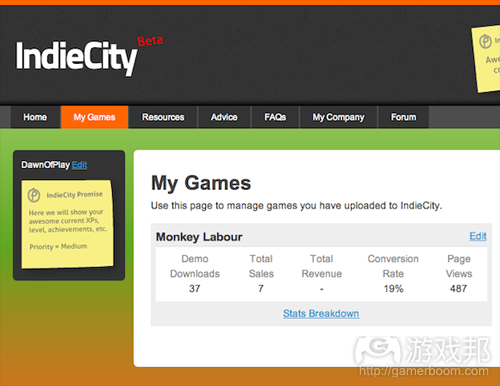


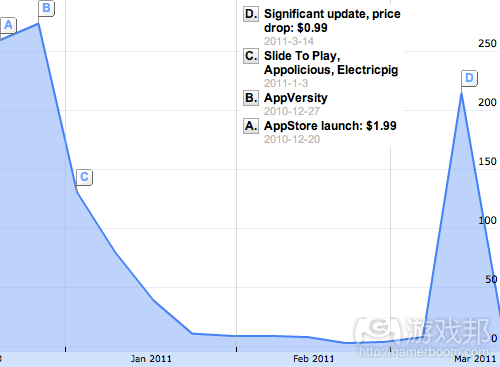


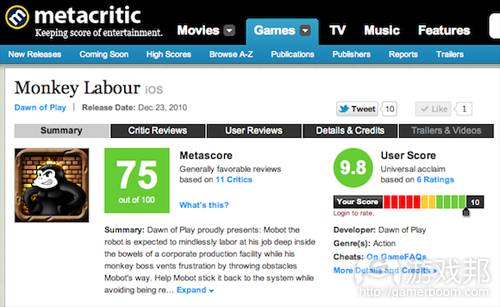
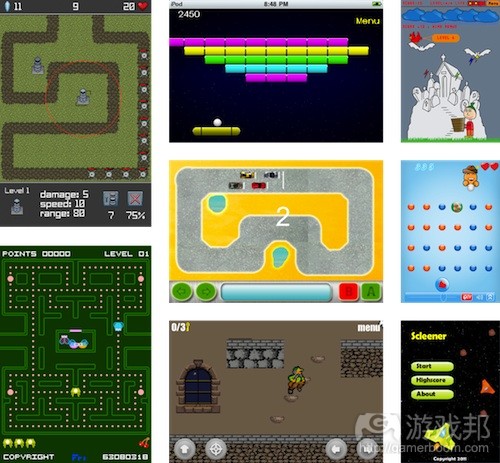
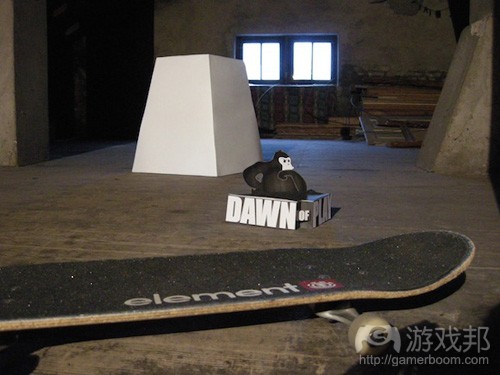
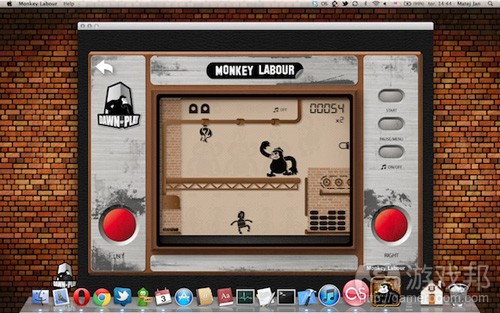














 闽公网安备35020302001549号
闽公网安备35020302001549号